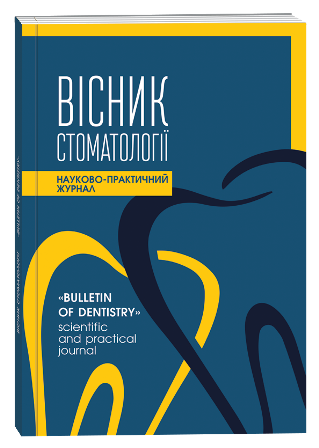ANALYSIS OF THE PREVALENCE OF FILLINGS IN THE TEMPORARY TEETH OF CHILDREN LIVING IN THE LOWLAND AND MOUNTAIN AREAS OF TRANSCARPATHIA
DOI:
https://doi.org/10.35220/2078-8916-2024-52-2.16Keywords:
temporary teeth, children, fillings, glass ionomer cements, compomers, prevalence of filled teeth, mountainous and lowland geographical areas.Abstract
The aim of the study. To analyze the prevalence of fillings made of different restorative materials in the temporary teeth of children who live in the lowland and mountainous geographical zones of Transcarpathia. Materials and methods. A content analysis of medical documentation, in particular the medical cards of dental patients (form 043) of LLC "University Stomatological Polyclinic" (Uzhgorod) and the dental office of Rakhiv District Hospital (Rakhiv), which treated dental caries in the period 2018–2022, was carried out a total of 700 medical cards of dental patients, of which 520 cards were isolated. The results. When conducting a content analysis of 520 medical cards of the children's population of Zakarpattia region, of which 310 live in lowland and 210 in mountainous geographical zones, the presence of 710 filled temporary teeth was determined. Regarding the material from which fillings are made in children of the lowland zone, fillings made of compomers were the most common: 145 fillings – 36.7%, of which 80 in molars – 20.3%, 50 in incisors – 12.6% and 15 in fangs – 3.8%. The second most common were fillings made of light-curing composite materials, 34.2% – 135 fillings, of which 80 in incisors – 20.3%, 35 in molars – 8.9% and 20 in canines – 5.0%. Fillings made of glass ionomer cements accounted for 29.1% – 115 units, of which 95 were in molars – 24.1%, and 10 each in incisors and canines (2.5% each). Among the children of the mountain zone, fillings made of light-hardening composite materials were the most common, 41.3% – 130 units, of which 50 fillings were in incisors and molars (15.9%) and 30 in canines – 9.5%. The second most common were fillings made of glass ionomer cements 34.9% – 110 units, of which 60 in molars – 19.0%, 35 in incisors – 11.1% and in 15 canines – 4.8%. Fillings made of compomers accounted for 23.8% – 75 units, of which 50 in molars – 15.9%, 20 in incisors – 6.3% and 5 in canines – 1.6%. Conclusion. Thus, the obtained results showed that fillings in molars made of glass ionomer cements prevailed in temporary teeth in 24.1% of cases (95 units) in children from the lowland zone, and in 19.0% of cases (60 units) in children from mountain zone of Transcarpathia.
References
Годованець О., Котельбан А., Гринкевич Л. Поширеність та інтенсивність раннього дитячого карієсу в дітей Буковини. Вісник стоматології. 2021. № 115(2). С. 59–62. URL: https://doi.org/10.35220/2078-8916- 2021-40-2.11
Біденко Н.В. Ранній карієс у дітей: стан проблеми в Україні і в світі. Сучасна стоматологія. 2007. No 1. С. 66-72
Дуда Л.В., Лебідь О.І. Поширення стоматологічних захворювань серед дітей віком 6 –9 років. Клінічна стоматологія. 2019. №1. С.48 – 51. URL: https://doi.org/ 10.11603/2311-9624.2019.1.10147
Klitynska O. V., Stishkovskyy A. V., Hasiuk N. V., Avetikov D. S. Statistical analysis of the impact of clusters on caries prevalence and intensity in children aged 6-7 with different somatic health statuses. Wiadomości lekarskie.2020. T. LXXIII. №3. P. 434-440. URL: https://doi.org/10.36740/WLek202003104.
Хоменко Л. О., Біденко Н. В. Ранній карієс тимчасових зубів: перспективи вирішення проблеми. Клінічна стоматологія. 2011. №1-2. С. 64-68.
Клітинська О.В., Стішковський А.В., Гасюк Н.В. Аналіз впливу рівня стресу у дітей 6-7 років, які постійно проживають в умовах біогеохімічного дефіциту фтору та йоду на показники захворюваності на карієс. Буковинський медичний вісник. 2020. Т. 94.
№ 2. С. 46–51. URL: https://doi.org/ 10.24061/2413-0737.XXIV.2.94.2020.42
Григоренко Н.М., Хоменко Л.О., Сороченко Н.В., Капітанчук Л.М.. Дослідження in vitro поверхневого шару емалі постійних зубів у період вторинної мінералізації. Український стоматологічний альманах. 2015. № 1. С. 11-15. URL: https://dentalalmanac.org/index.php/journal/article/view/2/2
Клітинська О.В., Шетеля ВВ. Обгрунтування вибору пломбувального матеріалу з урахуванням ступеню карієсрезистентності емалі зубів у дітей. Україна. Здоров'я нації. 2019. Т.54. №1. С.150-153. URL: https://doi.org/ 10.24144/2077-6594.1.0.2019
Navarro C.L.A., Grgic O., Trajanoska K., van der Tas J.T., Rivadeneira F., Wolvius E.B., Voortman T., Kragt L. Associations Between Prenatal, Perinatal, and Early Childhood Vitamin D Status and Risk of Dental Caries at 6 Years. J Nutr. 2021. No 151(7). Р. 1993-2000.
URL:https://doi.org/ 10.1093/jn/nxab075.
Brecher E.A., Lewis C.W. Infant Oral Health. Pediatr Clin North Am. 2018. No 65(5). Р. 909-921 URL:https://doi.org/10.1016/j.pcl.2018.05.016.
Mosaddad S.A., Tahmasebi E., Yazdanian A., Rezvani M.B., Seifalian A., Yazdanian M., Tebyanian H. Oral microbial biofilms: an update. Eur J Clin Microbiol Infect Dis. 2019. No 38(11). Р. 2005-2019. URL:https://doi.org/ 10.1007/s10096-019-03641-9
Майборода Р. Є. Комп'ютерна статистика : підручник. Київ : ВПЦ Київський університет, 2019. 589 с









